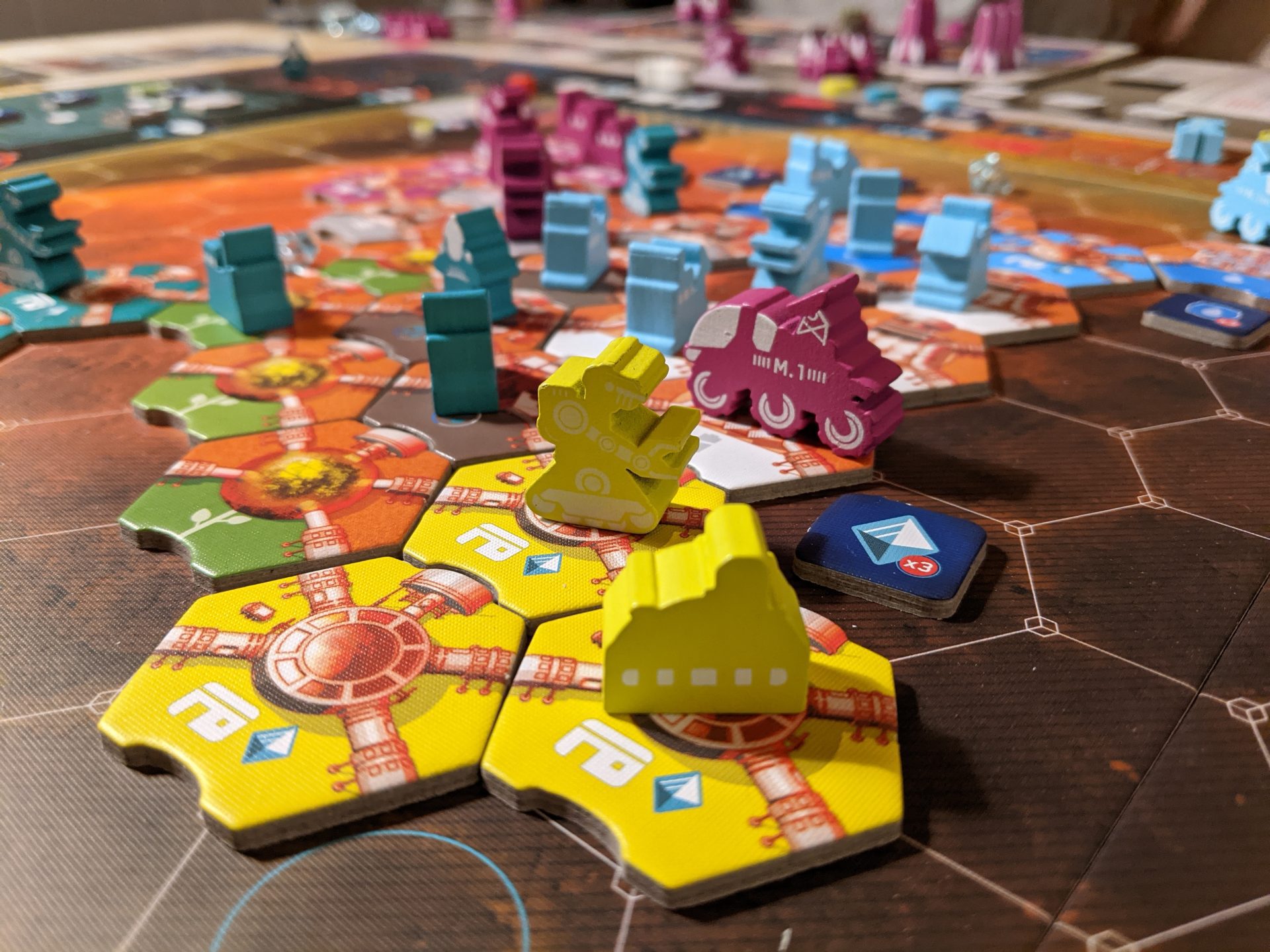My brain was still sizzling.
It was about 30 minutes after my latest play of On Mars, the 2020 release by prolific designer Vital Lacerda and my brain was in physical pain from all the crunchy decisions I had to make during our four-player game. Even though I had played the game multiple times before over the last 13 months, I was amazed at how much thought went into every turn, every decision, every agonizing moment. Then, after making what I thought was the right move for my in-game strategy, I realized there was something better left on the table.
Full disclosure: I play heavier-weight games like this sometimes, but my swim lane is dominated by mid-weight titles. The people in one of my game groups know that I live and die on the 3.0 line, meaning, when you visit BoardGameGeek (BGG) to look up a game’s weight, almost all of my favorites align with a 3.0 out of 5 in terms of complexity. Orléans is my number-one game for a reason: lots of interesting decisions, nearly zero downtime, interesting “bag builder” mechanic, iconography that’s easy to decipher, and the game is almost always over in 90 minutes or less. And, its BGG complexity rating? 3.03. Absolutely on point!
So, why do I love On Mars, with a complexity rating of 4.63, so much?

The Marriage of…So Many Things
As the chief astronaut (yes, really) of a private exploration company, the goal of On Mars is to score the most points over a series of rounds by being the best contributor to new colonies on the planet. Between the two halves of the worker placement areas of the board, you’ll spend time at the orbital station collecting resources and technologies to develop, or gathering blueprints to make your operations more efficient. Then you’ll go down to the surface of Mars to explore the terrain for valuable resources and scoring bonuses, build spaceships to shuttle your colonists between Mars and the orbital station, or utilize available scientists to help operate the advanced versions of the buildings you will construct over the course of the game.
On your turn, you’ll be able to take just one action on your side of the board, although most of your actions can be boosted through the use of extra supplies and/or workers. If you are in orbit (the left-hand side of the board), you’ll be able to select blueprints which will later be used to construct advanced buildings, which can trigger end-game scoring opportunities but also production bonuses and extra actions every turn (known as “Executive Actions” in Lacerda games). Other actions available to you in orbit include resource gathering, technology research and advancing those technologies on a track which can trigger additional end-game scoring opportunities as well as one-time bonuses.
In all of my plays of On Mars, I find that players spend the majority of their time on the right-hand side of the board, the colony side. You’ve got a wide array of options on the colony side of the board; you could bring new workers and bots to Mars, the latter of which are used to build buildings. You could instead use your rover to scout Mars for new building locations (and pick up resources and scoring bonuses on the planet’s surface), or hire scientists to use for Executive Actions. Later, the same action space used to hire scientists can be used to pick up contracts which provide additional end-game scoring opportunities if you fulfill resource or building alignments that match each contract’s requirements.
But the most important actions you will take on the colony side of the board? Build buildings and develop those buildings into advanced versions which help with your blueprints, and production, contracts to provide multiple opportunities to score mid-game and end-game points.
In addition to completing missions tied to taking certain actions, buildings are what help drive On Mars to its eventual completion: the game’s timer is tied to getting the planet ready for colonization. Building any of the four main building types (including greenhouses, water extractors and generators) when the colony needs them most pays out with points and one-time bonuses; however, building any of those four types when they are not needed, or building a mine at any time, does not advance this timer. Timing your build actions correctly also gives you chances at mid-game scoring when the colony levels up, which will happen 2-3 times per game when all four of the main building types move up their respective tracks.
For a mid-weight game lover like me, there’s a lot going on here. Resource management. Worker placement (and worker retrieval, which is often the more difficult action to plan), with a starting worker allotment that always feels just a tad too small for an endeavor like, I don’t know, colonizing another planet. Secret goals. A tech tree which determines what everyone at the table can build. Variable turn order tied to bonuses on either side of the board. (Thankfully, but maybe not realistically, On Mars doesn’t have a financial/budgeting process to be managed, so you never have to worry about how much it would really cost to colonize another planet.)
Even the very first decision of the game–which side of the board should you start on–can create the kind of paralyzing stasis that can turn a game into a death march. I am fortunate to play mostly with players who recognize that we are playing a game, not curing cancer or writing the next Game of Thrones, so even our first game of On Mars only took about three hours, with subsequent four-player games coming in between 2-2.5 hours.
Maybe that is why I enjoy On Mars so much…it’s a longer, more complex game than I am accustomed to playing, but all of these decisions make sense. There are not actions on the board for the sake of making the game more complex. (I’m looking at you, Teotihuacan!!!) There’s a lot to chew on for each individual decision, but you see why that is from the very beginning of the game. And it can be very rewarding as you watch your engine build to near perfection by game end, especially in the act of finding ways to bring new workers to the planet, maximizing executive actions, and finding ways to keep crystals handy when you need to boost any of your actions.
But in the hands of people who really do struggle with analysis paralysis, this could easily turn into a four-hour game, and worse, a game where you will wait 10+ minutes between turns. (Personally, long-ish games are fine, but high downtime means I will just lose interest in playing. I don’t like to be the guy who opens my Instagram feed to pass the time, but I’ve been known to do it when I grow impatient!!) Know your community and you’ll be fine here.

“The Best…or Nothing”
Like the advertising tagline for Mercedes-Benz, you have to give it to the folks at Eagle-Gryphon Games: they charge a lot of money for their products, and for that, you consistently get the best package deals in gaming. The components, the packaging–who doesn’t love unboxing an EGG–the stellar artwork by Ian O’Toole (a 2020 Diamond Climber nominee for Best Artwork for this game), the player boards. Even the hefty red mission markers feel great in your hands.
This is a luxury good, for players who are investing in a production, not grubbing at a fast-food restaurant to eat their next meal. Similar to other EGG/Lacerda games (Escape Plan, Vinhos Deluxe, Lisboa, The Gallerist, Kanban EV), there’s a brief moment where I wondered if it was worth plunking down this much money for a board game. But then I look up and realize that I’ve just committed to another purchase!

Lacerda’s Greatest Work
For those who pray at the altar of Lacerda, all of us have a favorite. (Meeple Mountain ran an interview with Vital Lacerda in 2018.) Marrying tight gameplay and a real-world theme,The Gallerist is the experience that most closely resonates with me; heck, when a friend of mine who previously worked as a curator at The Art Institute of Chicago saw The Gallerist on the table and got a sense of how the rules worked, she was really struck by how well Lacerda captured the various elements of running a successful gallery.
However, at the end of the day, I’m not an artist. But I am a sucker for great science fiction.
And that’s why I prefer On Mars. This is pure strategy at its finest, with a theme I always enjoy. Everything matters. Everything is fun to explore. I particularly enjoy watching other players get their engine going. The board gets crowded as players build their community from a small shelter mere spaces away from a mine that counts as the center of the board, resources are tight from a shared market at the orbital station, and worker placement spots for each of the game’s main actions are limited. This makes each turn exciting as you endeavor to plan ahead for executing your plan, but also requires having two or three backup options ready to go, with actions that can still help you achieve victory in the end.
While The Gallerist is Lacerda’s highest-ranked game on BoardGameGeek, I really think that by the end of 2022 (when people have had the chance to reconvene with their regular gaming groups and give games the time they deserve), On Mars will be his top entry. EGG recently announced an expansion is on the way, so the game continues to show impressive progress just a year after release. I’m already excited to get this one back to the table!











